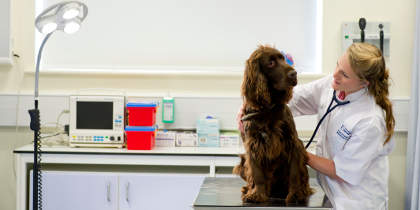
January 15, 2008, by Teaching at Nottingham
Do we select the right students? Analysis of the 1st year performance of students selected through a multi component interview procedure
Michael Jones, Nigel Kendall, Cyril Rauch and Sabine Totemeyer:
Introduction: “Applications for vocational courses such as veterinary medicine far exceed the number of places available. In 2006 the School of Veterinary Medicine and Science (SVMS) had 840 applications for 95 places. The course at SVMS differs from more traditional courses delivered at other institutions:
- The subject material is heavily integrated in both vertically and horizontally
- Practical skills and problem based learning is introduced earlier compared to traditional courses
SVMS therefore has a desire to recruit students whom can achieve academically to a high level and perform well in problem based and practical tasks. To this end SVMS utilised a multi-component interview procedure scoring candidates on a number of criteria. There were two stages in the selection.
- Stage 1 – Interview pre-selection: UCAS application and an additional school specific questionnaire are used to select students that are invited for interview.
- Stage 2 Multi component interview: An interview comprising an oral interview and a problem based practical test.
“Both these are structured and the students are scored on five desirable criteria. This study investigated whether the student performance in any particular component of the interview was a predictor for success within the course and hence have we selected the right candidates.
Results: “We compared student scores from the different parts of the interview process to the assessments during their 1st year of the course. Data were analysed using ANOVA as appropriate to identify correlations between selection criteria and course performance, summarised in Table 1. We also obtained feedback on how the students perceived the selection process.
Conclusions: “Yes, according to 1st year performance the interview process does select the right students. The overall achievement of the cohort of students was high. No single parameter could be negatively linked to performance. In addition, we observed that in-course assessments (20% of mark) were a good indicator of end-of-year performance (80% of mark) and could be used to highlight struggling students at an early stage. The overall performance of individual students did not significantly vary with the assessment type (practical or essay/multiple choice) strongly suggesting that our selection criteria did not bias the students against one particular aptitude. The main limitation of this study is that we could not test the performance of those students who failed to gain entry to our course. The competition for places means that majority of successful applicants are of high academic standard and therefore little variation could be observed between them. Combined with the low sample numbers it meant identifying discriminating factors proved difficult. More student cohorts would have to be followed over the whole course to investigate if we are not only select the right students for year 1 but also successful and satisfied professionals.”
| Table 1: Summary of data compared from pre-selection and assessments from year 1 | ||
|---|---|---|
| Criteria compared | Linked | Comments |
| A level score (UCAS) on entry vs. final mark | No | Based on final marks |
| Age upon entry vs. final mark | No | |
| Interview and practical vs. final mark | No | Combined interview score |
| Interview score vs. final mark | No | |
| Practical score vs. final mark | No | |
| Practical score vs. practical assessment | No | |
| In course vs. final summative assessment | Yes | |
| Background education | No | Graduate non graduate entry |
| Gender | No | |
Paper presented at the University’s Twelfth Learning & Teaching conference (January, 2008).
| Dr Michael Jones Lecturer in Microbiology and Molecular Biology School of Veterinary Medicine & Science |
Dr Nigel Kendall Lecturer in Nutrition School of Veterinary Medicine & Science |
| Dr Cyril Rauch Lecturer in Cell Biology and Biophysics School of Veterinary Medicine & Science |
Dr Sabine Totemeyer Lecturer in Cellular Microbiology School of Veterinary Medicine & Science |
This article was originally published as part of PESL’s Teaching at Nottingham collection.
No comments yet, fill out a comment to be the first

Leave a Reply